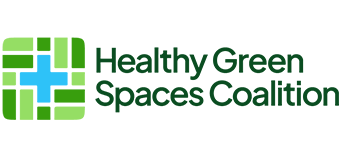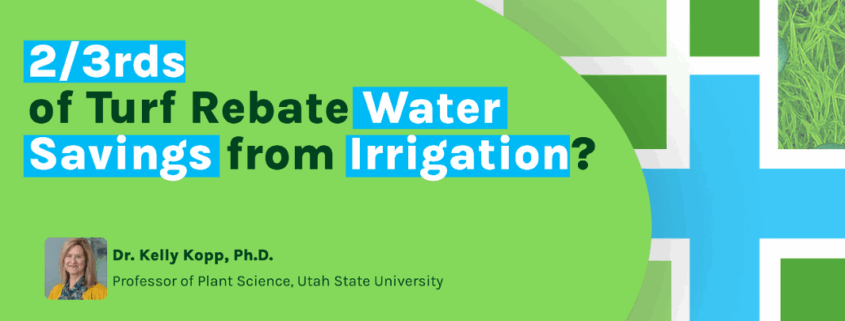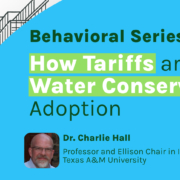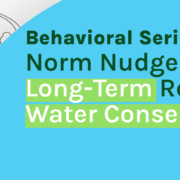Data Show Two-Thirds of Turf Rebate Savings Come from Irrigation Updates
Executive Editor: Steve Whitesell
Expert Reviewer: Dr. Kelly Kopp
Across the Western U.S., utilities are spending millions paying homeowners to replace lawns with xeriscapes and adapted plant materials. The visual impact is striking — but the real driver of water savings isn’t what’s changed above ground. It’s what’s changed below ground.
Research Highlights
- Irrigation can account for more than 65% of residential water consumption
- In four historic turf replacement programs, 2/3rds of water savings was attributed to irrigation system upgrades
While “Cash for Grass” and other turf removal programs are often credited with water savings, data show that most of the savings come from irrigation system upgrades and scheduling changes — not the plant materials themselves.
Meet Our Expert
Dr. Kelly Kopp has spent over two decades working directly with utilities, municipalities, and landscape professionals to design and evaluate landscape water conservation programs. She leads Utah’s Water Check Program, a statewide irrigation auditing initiative, and has published widely on irrigation efficiency, turfgrass science, and water policy.
Her outreach includes more than 30 national radio and TV interviews for National Lawn Care Month and recent features with Apartment Therapy and KSL on outdoor water use. She is also a monthly contributor to Utah Public Radio’s “The Green Thumb”, offering timely advice on landscape water conservation topics.
“I’ve seen programs all across the West,” Kopp says. “When you really dig into the numbers, irrigation upgrades — scheduling, system design, and maintenance — are the most consistent source of lasting water savings.”
Irrigation Improvements Drive Substantial Water Savings in Turf Replacement Projects
Peer-reviewed evidence shows that 2/3rds of water savings attributed to “Cash for Grass” programs come from updated irrigation systems and improved irrigation scheduling. Those findings align with feedback Dr. Kelly Kopp has heard from throughout the industry.
“I was recently in a meeting where a water conservation professional in California stated that the only actual water savings they were seeing were from natural grass areas with overhead irrigation that were being managed by professional landscape contractors,” Kopp said.
An analysis of “Cash for Grass” landscape replacement programs in California, Texas, Nevada, and New Mexico from the 1990s through the early 2000s reinforces this idea.
The Texas program produced the least savings at the highest cost because it did not require irrigation system upgrades. In contrast, programs in Nevada and California — which mandated or strongly incentivized irrigation improvements — achieved three to four times greater water savings per dollar spent.
Across the four historic turf replacement programs analyzed, the differences in results were striking:
- Las Vegas, Nevada: 62 gallons saved per square foot of turf replaced — $532 per acre-foot of water saved
- Marin, California: 33 gallons, $512 per acre-foot
- Albuquerque, New Mexico: 19 gallons, $718 per acre-foot
- El Paso, Texas: only 18 gallons saved, at a cost of $1,834 per acre-foot
That disparity reinforces what utilities in the western U.S. have long observed: the biggest water savings don’t come from removing turf. They come when turf replacement is paired with modernized irrigation systems and efficient water management practices.
“This is consistent with my observations that the way irrigation systems are used, not the plant material, is the most important factor and means to actual water conservation,” Kopp added.
Current Water-wise Case Studies in Las Vegas and Southern California
The Southern Nevada Water Authority (SNWA) still runs its turfgrass replacement program, offering residents between $2.50 and $5 per square foot of grass replaced, provided overhead irrigation is also removed.
Contemporary analysis of the SNWA’s turfgrass removal program puts the total water use reduction at approximately 5,000 gallons per month, a savings that remains consistent over the years.
It’s clear that current programs are influenced by past turf removal campaigns, as the Metropolitan Water District of Southern California spells out:
“Following the success of other incentive programs focusing on landscaping and turfgrass removal, the turf replacement program aims to combine turf removal, irrigation modification and rainwater retention or filtration to support reuse or soil absorption of rainwater.”
Modernized Irrigation Eliminates Water Waste
Water nurtures healthy lawns and landscapes which is the reason residents in the southwestern U.S. employ irrigation to supplement natural precipitation.
However, 30-60% of wasted water in the U.S. may be attributed to irrigation issues.
And while it’s true that turfgrass replacement campaigns introduce residents to xeriscape plants with low water demands, irrigation upgrades deliver comparable or greater savings with fewer barriers to adoption.
- Drip irrigation helped fuel success in the Valley Water Landscape Rebate Program in California.
- Modernized and calibrated irrigation systems also lead to reduced water losses from runoff.
- Irrigation maintenance as part of optimized landscape design leads to prolonged water savings.
“I can estimate 30% savings from irrigation improvements and appropriate scheduling based on my personal research and work here in Utah,” Kopp said.
And remember: not all irrigation upgrades are created equal.
Landscape transformation, though, must go hand-in-hand with education. That applies to both irrigation upgrades and full landscape replacements.
Residents, business owners, and everyone else who irrigates their landscapes needs proper guidance to ensure they are using the proper amount of water for their plant’s needs. While we’d all love to ‘set it and forget it,’ a little bit of monitoring can go a long way toward saving water.
Turfgrass Replacement Creates Viral Spillover due to the Visual Impact of Lawn Transformation
Landscape replacements featuring xeriscape plants create a visual viral spillover effect that expands the effectiveness of the program.
The Metropolitan Water District of Southern California, for example, documented that for every 100 water-wise rebates they provided an additional 132 lawn renovations were completed, demonstrating an incredibly wise use of rebate funds.
With viral spillover like that, does it matter where the savings really come from — the plants or irrigation systems?
Lawn maintenance upgrades should focus on water savings, and the best way to save water seems to be to upgrade existing irrigation systems with smart controllers and other new technologies. If water conservation managers focused on how to create virality with irrigation system upgrades instead of focusing all their efforts on turfgrass replacement, the water savings would be similar and barriers to participation would be less.
Start with Irrigation Upgrades to Save Money & Water Fast
It’s clear that water savings from water-wise rebates comes primarily from irrigation upgrades. However, there’s not one answer to reducing residential water use.
For instance, in a study evaluating 25 years of results from Las Vegas’ turfgrass replacement participants researchers found that turfgrass conversions reduce water use by 19-21%.
However, low rates of adoption limit the effectiveness of such programs. And studies have shown that landscape conversion rebate programs don’t result in the amount of turfgrass removal needed to fuel substantive water conservation.
With fewer and fewer rebate dollars to go around, water conservation managers should look to irrigation system upgrades before spending more money on turfgrass replacement campaigns.
Irrigation technology and management are more important than vegetation type with regard to water conservation
“Water managers don’t necessarily see savings when removing turf and converting to drip because people/irrigators can be quite wasteful with drip as well,” Kopp said.
Bottom line: appropriate irrigation management is the best path forward, whether you’re irrigating turf or something else.
References
Addink, S. 2008. “‘Cash for Grass’—A Cost Effective Method to Conserve Landscape Water?” https://turfgrass.ucr.edu/reports/topics/Cash-for-Grass.pdf
Baker, J. 2021. “Subsidies for succulents: Evaluating the Las Vegas Cash-for-Grass rebate program.” Journal of the Association of Environmental and Resource Economics.
Bijor, N. 2021. “Saving water with a landscape water conservation rebate program.” Journal AWWA
Brelsford, C. Abbott, J. 2021. “How smart are ‘Water Smart Landscapes?’” Journal of Environmental Economics and Management
Sovocool, K. Morgan, M. Bennett, D. 2006. “An in-depth investigation of Xeriscape as a water conservation measure.” Journal AWWA.
.














